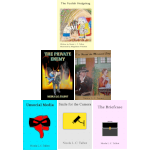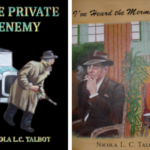Dickimaw Books Blog 
Norfolk 🔗

[Originally posted on Goodreads 2017-06-16.] The Private Enemy is set predominantly in Norfolk, mostly in and around the city of Norwich and in a fictional rural Fenland neighbourhood in the west of Norfolk. The story may be set in the future but, much like today, the people living there aren’t homogeneous. They vary according to their upbringing, social status, employment and surroundings. Norfolk inhabitants are so often unfairly stereotyped in the media as ignorant, Mummerset-speaking, inbred rustics that I thought it might be useful to give a brief overview of the real Norfolk and how the fictional Norfolk of the novel differs from it. (There may be mild spoilers below in terms of the back story, but most of it’s already in the book blurb.)
Norfolk is a largely rural county, and its culture has been influenced by its geography (amongst other things). Situated in the east of England, with the North Sea to the east, north, and north-west, it’s not really a place that travellers pass through on route to somewhere else. In the past, it was even more isolated before the Fens in the west were drained (although that was done a long time ago). The transport links have improved in recent years with a more frequent intercity train service and the duelling of the A11. On the other hand, the rural public transportation within the county has declined.
However, despite its apparent isolation, Norfolk’s culture and language have been shaped by incomers over the centuries: Romans, Angles, Saxons, Danes and Normans have all left their mark. Later, and more peacefully, came the Strangers — refugees from the Low Countries. (The word ‘stranger’ originally meant not a native of that place, but the Strangers in Norfolk has come to mean those particular immigrants.) Their influence can be seen in Norfolk architecture, the language, names and even symbols, such as the canary.
The modern strangers are from further afield, such as Eastern Europe, but there are also incomers from other parts of the UK, include those retiring here, those who fell in love with the county when visiting it on holiday, and those who came here for work placements. (My husband falls into that last category. We moved here in the mid 1990s having both studied at the University of Essex where we met.)
Norfolk is a lovely county with deep roots, but the seeming idyll masks homelessness and poverty. The future Norfolk of The Private Enemy has this same mixture, but in addition it has urban gangsters openly engaging in territorial disputes (which thankfully the real Norfolk doesn’t have).
This deviation from reality is due to events in the back story. Thirty-two years before the start of the novel (at some point in our near future), a fuel crisis triggered global anarchy that lasted two years. Peace was restored and the concept of nationality was abolished. The purported reason for this is that nationalism can cause conflict. Instead the world is divided into numbered sectors with a new capital city (to avoid any associations with the past) in the middle of each region. Sector 1 is the overall administrative centre and is the effective global ruling body.
In reality, far from creating the continually advertised ‘one world united in peace and prosperity’, the sectors (which mostly correspond to the old boundaries) are more fractured than before. Since the story is set mostly in Norfolk, with a few scenes in the capital city for this sector (Sector 55), the focus is on the fractures in this particular region.
The enmity between the rural and urban areas is a result of city raiders invading farmland during the anarchy. The passage of time hasn’t softened the long-held grudges of those who had to defend their homes and families against attack. Within the urban areas, rival gangs emerged during the anarchy to compete for resources, and they still hold sway through corruption and force of arms. So the fictional future Norwich is divided up into neighbourhoods controlled by gangsters and the so-called ‘Neutral Territory’, controlled by financiers and politicians, which acts as a buffer zone.
There are also ideological divides. The ‘Anti-Technology League’ want curbs on technology, claiming that the unsustainable energy demands required by high levels of technology caused the anarchy. Other groups want technological growth (or regrowth). The Anti-Techs seem to get their way some of the time, but Sector 1 are rather selective as to which demands they apparently submit to. Computers are banned, except for government departments (since they’re needed for administrative purposes). This means no Internet, emails or other forms of global electronic communication. Most mobile phone masts were destroyed during the anarchy and haven’t been replaced. This just leaves landlines for instant communication. There are no televisions, but there are cinemas. Radios are back to being analogue, which means they’re subject to static (and if that static happens to interrupt news items, only the paranoid would consider that censorship). And just to show that the Anti-Techs aren’t an all-powerful lobby group, Sector 1 has refused to ban electronic billboards used for product advertising (interspersed with little messages from your friendly politicians).
The Anti-Tech’s message that our modern gadget-filled world caused the anarchy has fuelled nostalgia, and the mismatched retro fashions reflect the desired idylls. This is further back in time for the rural areas than for the city, and the labour-saving devices, such as washing machines, that still exist are used but kept out of sight and not discussed in polite conversation (more a case of keeping back with the Joneses rather than keeping up with them).
The most prominent gangster in future Norwich is Jack Preston. The anarchy broke out when he was eleven years old. A fan of film noirs from the 1930s and 1940s, his adoption of a gangster style image from that era was essentially a coping mechanism, but he becomes so powerful and influential that others copy him, and he now drives the fashion in this region. (Other regions fall back on other styles. The reduced global communications means that sectors start to diverge.)
The next most prominent gangster, and Jack’s rival, is Big Stan O’Brien. He doesn’t want to be seen to be copying Jack, so he taps into his Sector 53 ancestry and adopts a Godfather-like figure, but since this mash-up is from Jack’s preferred era, he’s still effectively mimicking Jack.
So how do people talk in future Norfolk? Much like today, there are a variety of accents. The native Broad Norfolk is still in use, but social status is also a factor. As in real life, there are some professionals who grew up with Broad Norfolk but softened it as they moved up the promotional ladder (for example, this is the case with Detective Inspector Charles Hadley). There are also professionals who don’t soften their accents (Detective Sergeant Sarah Fenning) as they view it as part of their identity. In the city there are those who have a Norwich accent, and then there are those who are trying to copy Jack or Stan’s affectations. There are also incomers with their own accents.
That’s the world of The Private Enemy, but the difficulty came in deciding how to represent these various accents. Writing guides frown on the use of funetik, and they have a point. It can be quite incomprehensible. The first 10,000 words of this novel formed the major part of my portfolio for my diploma in creative writing. The work has also been critiqued on other courses and writing groups, and at various times I’ve used various approaches, including following the much advocated advice to use dictionary spelling and allow the word choice and cadence to establish the voice. After all, if I’m spending all that time studying the art of creative writing, I ought to follow the laws laid down by the experts.
I dutifully corrected all the spelling and sent my first chapter round to my latest group. The result?
Is [Broad Norfolk character] American?
How did that happen? I’d used Norfolk syntax, so why did it sound American? (This wasn’t Jack’s hard-boiled affectation.)
Earlier, I mentioned immigrants to Norfolk, but I didn’t mention the emigrants. When you saw the word Norfolk in this blog’s title, did you immediately think of Norfolk, England (famous for its admiral) or Norfolk, Virginia (famous for its naval base)?
One of the earliest Englishmen to settle in the Virginia colony was Adam Thoroughgood from King’s Lynn, Norfolk (England). The early settlers undoubtedly brought their native accents with them, but over the generations the pronunciation of the sundered groups diverged as new immigrants from other areas arrived and the natural evolution of language occurred. However, despite this change, there are still a few elements common to Broad Norfolk and some parts of America that aren’t so common in the rest of the UK. For example, in Broad Norfolk ‘wholly’ is used in the sense of ‘very’, ‘yard’ can mean garden, and a person might address their friend as ‘ole partner’. So, while there are some very distinctive words and phrases in Broad Norfolk, there are a few cases that can superficially appear American if the pronunciation isn’t clarified.
Another bit of feedback from the group came in the form of corrections in a returned copy where the initial h’s from words in the dialogue were crossed out and replaced with apostrophes. Other dialects may drop their aitches but Norfolk doesn’t drop haitches. In addition, some of the dialect’s idiosyncrasies can look like typographical errors, such as the regularisation of the third person singular present tense (‘she do’, ‘he say’, ‘that look like rain’).
The problem with this creative writing rule is that it relies on the reader being familiar with the accent. Broad Norfolk is a little-known dialect that’s frequently misrepresented. There are so many times that I see this rule presented with some example dialogue followed by a statement that the reader will naturally hear such-and-such well-known accent when reading it.
The other advice to writers is to avoid dialects altogether and always use standard English, but the concept of standard English is a fallacy as English is a pluricentric language. (I’ve seen enough edit wars over the years to verify this.) There are standards within regions but even these can be disputed. Alice may believe that her public school accent is standard English and think that Bob sounds awfully common. Bob may believe his estuary accent is standard and think that Alice sounds a bit posh.
I could’ve saved myself a lot of headaches if I’d stuck with one specific textbook English for all the characters. Not only was the Broad Norfolk causing me problems, but also the hybrid accents for characters like Jack and Stan. However the drawback with standardizing the way everyone talks is that it suggests a lack of diversity, but the whole point of the setting was its fractured nature.
Incidentally, in case there’s any misunderstanding, I’m not a linguistic expert nor can I speak Broad Norfolk. My experience is limited to living in Norfolk for over twenty years and listening to people airing their views on the local radio, nattering on the bus, conversing with cashiers or checkout assistants, or chatting with friends and neighbours. (Any resident of Norfolk who claims that the dialect is extinct must be living in some kind of élite enclave.) I therefore decided to solicit the advice of Norfolk dialect expert Keith Skipper, which was just as well as it turned out that I’d unwittingly picked up some long-defunct words from an old book written by a late Norfolk author.
In the end, I decided on a small amount of spelling deviations. The feedback so far has included:
Didn’t like the dialect.
Really didn’t like the dialect.
Didn’t have a problem with the dialect.
Liked the dialect.
Would’ve liked more guide to the pronunciation.
Would’ve liked footnotes.
Haven’t got round to reading the story yet but really enjoyed reading the glossary of Norfolk terms at the back.
Which just goes to show that readers (like people in general) are diverse, and there’s no one-size-fits-all solution.
Incidentally, the second edition of The Private Enemy is due out on 30th September 2017. The font is smaller (10pt instead of 11pt) and the layout is more compact. This has reduced the page count and overall size and weight, which means a reduction in print and postage costs and this will be reflected in a reduction in the retail price. The revised first edition will continue to be available until the end of September [2017]. More news on the new edition to follow in the next month or so.
Next Post
Previous Post
Recent Posts
 There are a growing number of digital historians who are interested in documenting old computing systems from the twentieth century, but much of the information has been lost and coincident names can make it hard to search. This article is about the RISC OS ARMTeX distribution, which provided TeX and LaTeX for the ARM-powered Acorn computers in the 1990s.
There are a growing number of digital historians who are interested in documenting old computing systems from the twentieth century, but much of the information has been lost and coincident names can make it hard to search. This article is about the RISC OS ARMTeX distribution, which provided TeX and LaTeX for the ARM-powered Acorn computers in the 1990s. The DRM-free ebook retailer SmashWords has its annual Summer/Winter sale from 1st – 31st July 2025. My crime novel “The Private Enemy” and children’s illustrated story “The Foolish Hedgehog” both have a 50% discount, and my crime fiction short stories “I’ve Heard the Mermaid Sing”, “Unsocial Media”, “Smile for the Camera”, and “The Briefcase” have a 100% discount (i.e. free!) for the duration of the sale. Did you know that you can gift ebooks on SmashWords?
The DRM-free ebook retailer SmashWords has its annual Summer/Winter sale from 1st – 31st July 2025. My crime novel “The Private Enemy” and children’s illustrated story “The Foolish Hedgehog” both have a 50% discount, and my crime fiction short stories “I’ve Heard the Mermaid Sing”, “Unsocial Media”, “Smile for the Camera”, and “The Briefcase” have a 100% discount (i.e. free!) for the duration of the sale. Did you know that you can gift ebooks on SmashWords? If you have read my short story Smile for the Camera, did you notice that the ending could have two possible interpretations? (No spoilers please!) As a writer, it’s always difficult to tell if something is too obvious or too obscure. If you need a hint, consider the naming scheme and remember that not everyone is what they say or imply that they are.
If you have read my short story Smile for the Camera, did you notice that the ending could have two possible interpretations? (No spoilers please!) As a writer, it’s always difficult to tell if something is too obvious or too obscure. If you need a hint, consider the naming scheme and remember that not everyone is what they say or imply that they are. The Ex-Cathedra writing group were delighted to present a cheque for £1,400 to St Martins Housing Trust during their collection at Tesco Harford Bridge on 6th December 2024. The money was raised from sales of the book Tales for Our Times, an anthology of short stories written by the group. The cheque was received by Ian Hanwell on behalf of St Martins. Many thanks to the support of everyone who purchased a copy and to the staff at Tesco Harford Bridge for allowing us to make the presentation there.
The Ex-Cathedra writing group were delighted to present a cheque for £1,400 to St Martins Housing Trust during their collection at Tesco Harford Bridge on 6th December 2024. The money was raised from sales of the book Tales for Our Times, an anthology of short stories written by the group. The cheque was received by Ian Hanwell on behalf of St Martins. Many thanks to the support of everyone who purchased a copy and to the staff at Tesco Harford Bridge for allowing us to make the presentation there. Search Blog
📂 Categories
- Autism
- Books
- Children’s Illustrated Fiction
- Illustrated fiction for young children: The Foolish Hedgehog and Quack, Quack, Quack. Give My Hat Back!
- Creative Writing
- The art of writing fiction, inspiration and themes.
- Crime Fiction
- The crime fiction category covers the crime novels The Private Enemy and The Fourth Protectorate and also the crime short stories I’ve Heard the Mermaid Sing and I’ve Heard the Mermaid Sing.
- Fiction
- Fiction books and other stories.
- Language
- Natural languages including regional dialects.
- (La)TeX
- The TeX typesetting system in general or the LaTeX format in particular.
- Music
- Norfolk
- This category is about the county of Norfolk in East Anglia (the eastern bulgy bit of England). It’s where The Private Enemy is set and is also where the author lives.
- RISC OS
- An operating system created by Acorn Computers in the late 1980s and 1990s.
- Security
- Site
- Information about the Dickimaw Books site.
- Software
- Open source software written by Nicola Talbot, which usually has some connection to (La)TeX.
- Speculative Fiction
- The speculative fiction category includes the novel The Private Enemy (set in the future), the alternative history novel The Fourth Protectorate, and the fantasy novel Muirgealia.
🔖 Tags
- Account
- Alternative History
- Sub-genre of speculative fiction, alternative history is “what if?” fiction.
- book samples
- Bots
- Conservation of Detail
- A part of the creative writing process, conservation of detail essentially means that only significant information should be added to a work of fiction.
- Cookies
- Information about the site cookies.
- Dialect
- Regional dialects, in particular the Norfolk dialect.
- Docker
- Education
- The education system.
- Ex-Cathedra
- A Norfolk-based writing group.
- Fantasy
- Sub-genre of speculative fiction involving magical elements.
- File formats
- Hippochette
- A pochette (pocket violin) with a hippo headpiece.
- History
- I’ve Heard the Mermaid Sing
- A crime fiction short story (available as an ebook) set in the late 1920s on the RMS Aquitania. See the story’s main page for further details.
- Inspirations
- The little things that inspired the author’s stories.
- Linux
- Migration
- Posts about the website migration.
- Muirgealia
- A fantasy novel. See the book’s main page for further details.
- News
- Notifications
- Online Store
- Posts about the Dickimaw Books store.
- Quack, Quack, Quack. Give My Hat Back!
- Information about the illustrated children’s book. See the book’s main page for further details.
- Re-published
- Articles that were previously published elsewhere and reproduced on this blog in order to collect them all together in one place.
- Sale
- Posts about sales that are running or are pending at the time of the post.
- Site settings
- Information about the site settings.
- Smile for the Camera
- A cybercrime short story about CCTV operator monitoring a store’s self-service tills who sees too much information.
- Story creation
- The process of creating stories.
- TeX Live
- The Briefcase
- A crime fiction short story (available as an ebook). See the story’s main page for further details.
- The Foolish Hedgehog
- Information about the illustrated children’s book. See the book’s main page for further details.
- The Fourth Protectorate
- Alternative history novel set in 1980s/90s London. See the book’s main page for further details.
- The Private Enemy
- A crime/speculative fiction novel set in a future Norfolk run by gangsters. See the book’s main page for further details.
- Unsocial Media
- A cybercrime fiction short story (available as an ebook). See the story’s main page for further details.
- World Book Day
- World Book Day (UK and Ireland) is an annual charity event held in the United Kingdom and the Republic of Ireland on the first Thursday in March. It’s a local version of the global UNESCO World Book Day.
- World Homeless Day
- World Homeless Day is marked every year on 10 October to draw attention to the needs of people experiencing homelessness.


